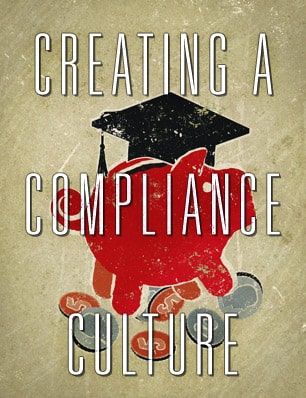Finance Training: Tips to Create a Compliance Culture
 What comes to mind when considering “training in the financial services industry”? For me it’s an easy one … compliance. Having worked in finance and held licenses to sell securities for over 15 years, I’ve taken my fair share of compliance courses. Like clockwork, every few months I’d find myself in front of a computer or instructor informing me a new regulation had passed and there were a new list of things I couldn’t do. I have to admit after taking such finance trainings year after year, my main motivation became simply to get through, achieving the title of “compliant” for yet another short period of time. Even worse, I began to think “is this really all my organization expects of me?”
What comes to mind when considering “training in the financial services industry”? For me it’s an easy one … compliance. Having worked in finance and held licenses to sell securities for over 15 years, I’ve taken my fair share of compliance courses. Like clockwork, every few months I’d find myself in front of a computer or instructor informing me a new regulation had passed and there were a new list of things I couldn’t do. I have to admit after taking such finance trainings year after year, my main motivation became simply to get through, achieving the title of “compliant” for yet another short period of time. Even worse, I began to think “is this really all my organization expects of me?”
Compliance vs. Compliance Culture
Nowadays, we frequently hear about insider trading scandals or people engaging in unethical financial actions. These instances have caused many organizations not only to increase compliance budgets but also rethink the ways in which compliance training is delivered. As opposed to traditional compliance training, the new goal has become to design programs that will create a compliance culture. The difference between compliance and a compliance culture centers on the motives of why we comply in the first place. One could compare it to more of a “gut check” than just checking off a list of do’s and don’ts. When you think about it, compliance shouldn’t be about being an expert on an array of rules and regulations; it should be more about saying and doing the right things as well as understanding the consequences of saying and doing the wrong things.
Here are three design tips to consider when developing programs to encourage a compliance culture:
- Rich-Media and Motion Pieces – Studies show that people retain a mere 10% of the information they read, 20% of the information they hear, but impressively 50% of the information they both see and hear1. Rich-media can engage, entertain and inform audiences faster and far more effectively than any other type of communication. At Allen, our in-house visual-media team works with our instructional designers to create custom pieces such as emotional ethics intros and video scenarios to realistically connect with audiences.
- The Learner Experience – Far too many learners approach compliance training with cynicism. When it comes to compliance training, the perception the learner holds of their experience is far more important than the content itself. Let’s face it: training programs will be far more successful if they are perceived by their learners as easy to follow, interactive, innovative and relevant. We take great pride in researching and becoming familiar with our client’s learner base so we can create highly customized training tailored to maximize the learner’s experience.
- Behavioral Changes – The best compliance programs strive to create behavioral changes in learners. At Allen we exercise performance mapping with every one of our projects to identify business goals of the training, selecting measurable metrics, and map out which behaviors need to change to reach the goals. Three components we focus on are critical thinking, skill mastery and motivation; each plays an integral role in affecting a change in one’s behavior.
As the popularity of compliance culture continues to grow, more and more businesses seek learning development expertise to create customized compliance training programs. Our expertise affords businesses the opportunity to re-vamp their learning programs, optimizing behavioral changes and re-exciting employees view on compliance.
How does your organization build a compliance culture? What are your challenges and successes?
Contact one of our Learning Directors to see examples and discuss how we help create compliance cultures.






Comments 1
Nice, since every scenario can’t be walked through in a compliance training session, focusing on creating a compliance culture instead allows organizations to trust that their employees will do the right thing when situations arise.